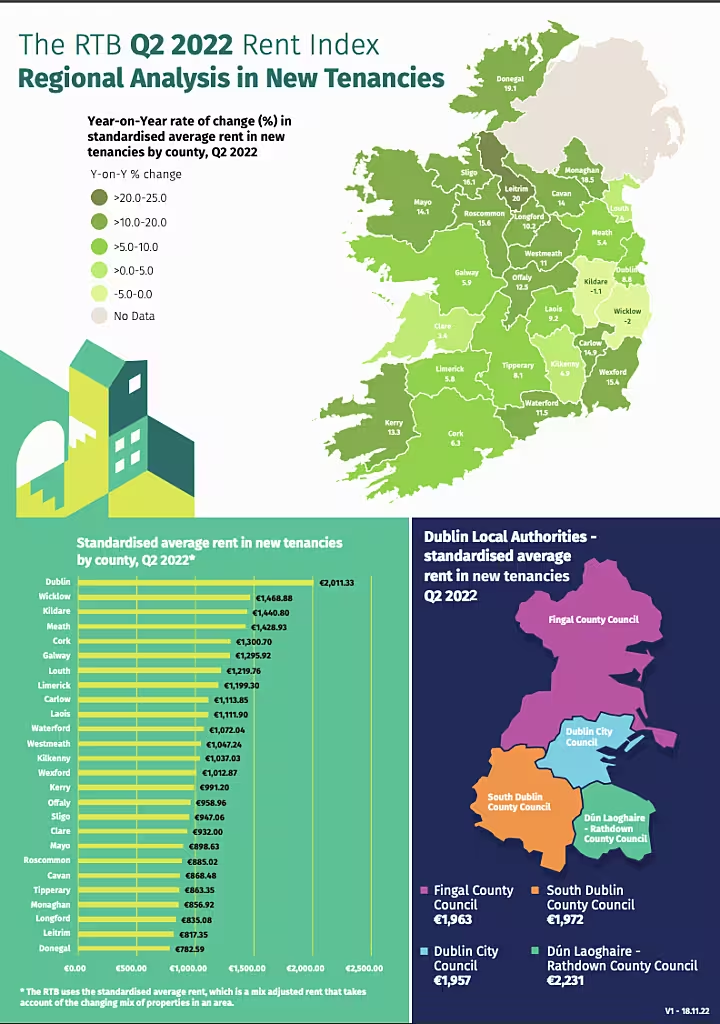The standardised average rent in newly registered tenancies in Ireland stood at €1,464 a month in the second quarter of 2022 – an increase of 8.2% year-on-year.
This was an increase of €9 per month compared to the previous quarter, according to the latest data from the Residential Tenancies Board (RTB).
The Rent Index measures rental price developments faced by those taking up new tenancies in the private rental sector and does not measure rents being paid by existing tenants.
The latest index shows that average rents for new tenancies in Dublin were €2,011 a month and outside Dublin they averaged €1,130 a month.
The highest standardised average rent in new tenancies for the second quarter of the year was in Dublin at €2,011 per month.
The lowest monthly rents were in Donegal, where the standardised average rent in new tenancies stood at €783 a month.
14 counties have standardised average rents in new tenancies above €1,000 per month during the three months from April to June - Carlow, Cork, Dublin, Galway, Kildare, Kilkenny, Laois, Limerick, Louth, Meath, Waterford, Westmeath, Wexford and Wicklow.
The index shows that the lowest yearly growth in the standardised average rent for new tenancies was in Wicklow where rents fell by 2%.
Kildare had the second lowest yearly growth rate, with rents falling by 1.1%.
The county with the fastest growing standardised average rent in new tenancies in Q2 2022 was Leitrim, which reported 20% year-on-year growth.
A total of 14 counties had a yearly growth rate in new tenancy rents above 10% in the three month period.
The latest Index analysed 12,701 new tenancy registrations, which is a decrease of 16% on the number of new tenancies included in the Q2 2021 Rent Index (15,048).
Dublin, and the Greater Dublin Area (GDA), accounted for over half (54.2%) of all new tenancy agreements registered in Q2 2022. 59.5% of new tenancies registered were for apartments.
Niall Byrne, RTB Director, commenting on the release of the RTB Q2 2022 Rent Index said: “The Q2 2022 Rent Index Report shows us that the national rent level for new tenancies across the country has continued to rise. We also see a continued decrease in the number of tenancies registered with the RTB in the quarter. These results are likely due to a mixture of factors including the continued limited supply of rental accommodation. It is important to state that these results are for new tenancies only and therefore these insights relate to only a small part of the private rental sector in Ireland.”
He continued: “Over the last 12 months, there have been some important changes for the RTB and for the sector. With the introduction of annual registration on 4 April 2022, and of our new tenancy registration system in November last year, the data analysis and reporting capabilities of the RTB will be improving significantly as we move into 2023. We acknowledge that the new registration system has created difficulties for some landlords and agents, and we are working hard to address these. As we move towards the completion of this first cycle of annual registration in April next year, we remain confident that annual registration will provide the RTB with much greater visibility on rents for both existing and new tenancies. This expanded data will allow us to provide new insights and improved information to tenants, landlords and the wider public during 2023 while also providing enhanced data to inform the development of policy for the residential rental sector.”








